 W
WAn unmanned ground vehicle (UGV) is a vehicle that operates while in contact with the ground and without an onboard human presence. UGVs can be used for many applications where it may be inconvenient, dangerous, or impossible to have a human operator present. Generally, the vehicle will have a set of sensors to observe the environment, and will either autonomously make decisions about its behavior or pass the information to a human operator at a different location who will control the vehicle through teleoperation.
 W
WBerserk is an unmanned remotely controlled combat complex that was developed in the Republic of Belarus in 2018. The combat complex is equipped with two four-barrel rapid-firing aircraft machine guns GShG-7.62 and designed for engagement of small-size UAVs and enemy troops. For the first time, Berserk was presented at the parade of troops of the Minsk garrison on July 3, 2019 in honor of Independence Day of the Republic of Belarus.,
 W
WDragon Runner is a military robot built for urban combat. At 20 pounds it is light enough to be carried and thrown. The original project was funded by the United States Marine Corps Warfighting Laboratory in conjunction with Carnegie Mellon University. It was designed at Carnegie Mellon University while the electronics and thermoplastic shell is developed and made by Automatika, Inc. Early development was conducted by the United States Naval Research Laboratory, including initial design, production and field testing.
 W
WThe Foster-Miller TALON remotely operated vehicle is a small, tracked military robot designed for missions ranging from reconnaissance to combat. It is made by US robotics company Qinetiq-NA, a subsidiary of Qinetiq.
 W
WThe Gladiator Tactical Unmanned Ground Vehicle program was developed in order to support the United States Marine Corps conduct of Ship To Object Maneuver (STOM) missions through the use of a medium-sized, robotic system to minimize risks and eliminate threats to Marines during conflict. The Gladiator is able to perform surveillance, reconnaissance, assault and breaching missions within its basic technical configuration.
 W
WGuardium, developed by G-NIUS, is an Israeli unmanned ground vehicle (UGV) used to combat and guard against invaders along Gaza's border. It was jointly developed by Israel Aerospace Industries and Elbit Industries. It can be used in either tele-operated or autonomous mode. Both modes do not require human interaction. The more unmanned ground vehicles patrolling the area the less human resources needed while guaranteeing deterrence. The joint program was terminated in April 2016, but the vehicle has remained in service with the Israel Defense Forces.
 W
WThe iRobot Warrior is an unmanned robotic platform from iRobot Corporation. The 285 lb (129 kg) robot can traverse land at up to 9.3 mph (15 km/h) and is capable of carrying up to 500 lb (227 kg), including 150 lb (68 kg) in its manipulator. Able to climb steps and slopes at up to 45°, the next generation of remote control robotic vehicles is bigger, faster, and more capable than their smaller counterparts. Initial intended uses are Explosive Ordnance Disposal, route-clearance, surveillance, enhanced security measures, scouting, reconnaissance, casualty extraction, firefighting, manipulating and welding.
 W
WThe Multi-function Agile Remote-Controlled Robot (MARCbot) is a military robot created by Exponent Inc. for the United States Army Rapid Equipping Force.
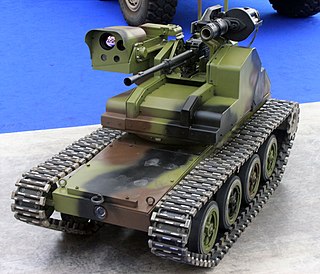 W
WMiloš, also called Little Milosh, is an unmanned ground vehicle (UGV) developed by the Military Technical Institute Belgrade, following the development of Unmanned ground vehicle Milica in 2009. UGV Miloš is in serial production and first customer are Serbian Armed Forces.
 W
WThe Panama Remotely Operated Vehicle (ROV) is a piece of mine-clearing equipment used by the British Armed Forces.
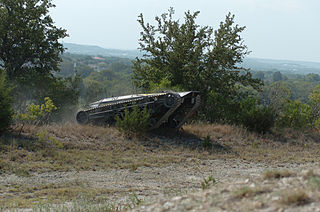 W
WThe Ripsaw is a developmental Unmanned Ground Combat Vehicle designed and built by Howe & Howe Technologies for evaluation by the United States Army. Howe & Howe Technologies was purchased by Textron Systems in December 2019.
 W
WTeletanks were a series of wireless remotely controlled unmanned tanks produced in the Soviet Union in the 1930s and early 1940s so as to reduce combat risk to soldiers. They saw their first combat use in the Winter War, at the start of World War II. A teletank is controlled by radio from a control tank at a distance of 500–1,500 metres, the two constituting a telemechanical group. Teletanks were used by the Soviet Red Army in the Winter War, fielding at least two teletank battalions at the beginning of the World War II on Eastern Front.
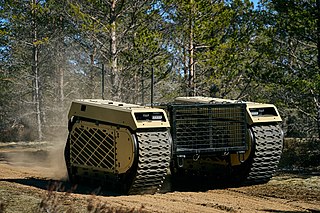 W
WTHeMIS, unmanned ground vehicle (UGV), is a ground-based armed drone vehicle designed largely for military applications, and is built by Milrem Robotics in Estonia. The vehicle is intended to provide support for dismounted troops by serving as a transport platform, remote weapon station, IED detection and disposal unit etc. The vehicle’s open architecture gives it multi-missions capability. The main purpose of the THeMIS Transport is to support onbase logistics and provide last mile resupply for fighting units on the front line. It supports infantry units by reducing their physical and cognitive load, increasing stand-off distance, force protection and survivability. THeMIS Combat UGVs provide direct fire support for manoeuvre forces acting as a force multiplier. With an integrated self-stabilizing remote-controlled weapon system, they provide high precision over wide areas, day and night, increasing stand-off distance, force protection and survivability. Combat UGVs can be equipped with light or heavy machine guns, 40 mm grenade launchers, 30mm autocannons and Anti-Tank Missile Systems. THeMIS ISR UGVs have advanced multi-sensor intelligence gathering capabilities. Their main purpose is to increase situational awareness, provide improved intelligence, surveillance and reconnaissance over wide areas and battle damage assessment capability. The system can effectively enhance the work of dismounted infantry units, border guard and law enforcement agencies to collect and process raw information and decrease the reaction time for commanders. THeMIS is capable of firing conventional machine gun ammunition or missile rounds
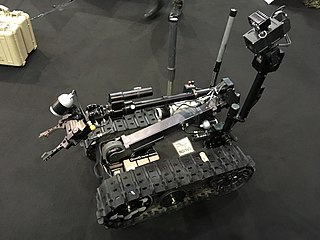 W
WUGV Interoperability Profile , Robotics and Autonomous Systems – Ground IOP or simply IOP was originally an initiative started by the United States Department of Defense (DoD) to organize and maintain open architecture interoperability standards for Unmanned Ground Vehicles (UGV). A primary goal of this initiative is to leverage existing and emerging standards within the Unmanned Vehicle (UxV) community such as the Society of Automotive Engineers (SAE) AS-4 Joint Architecture for Unmanned Systems (JAUS) standard and the Army Unmanned Aircraft Systems (UAS) Project Office IOPs.
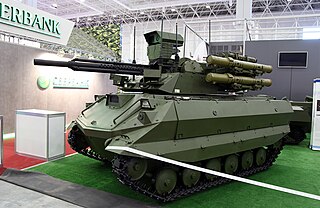 W
WThe Uran-9 is a tracked unmanned combat ground vehicle (UCGV) developed and produced by JSC 766 UPTK, and promoted and offered by Rosoboronexport for the international market. According to a release by Rosoboronexport, the system designed to deliver combined combat, reconnaissance and counter-terrorism units with remote reconnaissance and fire support. The armament consists of a 2A72 mod ABM M30-M3 autocannon from Impul's 2 (Sevastopol') along Russian artillery and other producers, four ATGMs of the Ataka or other type, also Igla or Strela SAMs, FCS, cam IR sensors, laser rangefinder and other means for detection.
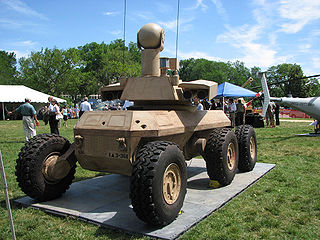 W
WThe XM1219 Armed Robotic Vehicle was an unmanned ground combat vehicle based on the MULE Platform. The ARV-A-L MULE Vehicle (XM1219) would feature integrated anti-tank and anti-personnel and reconnaissance, surveillance, and target acquisition (RSTA) systems remotely operated by network linked soldiers. The Armed robotic vehicle was canceled in July 2011 over mobility concerns.